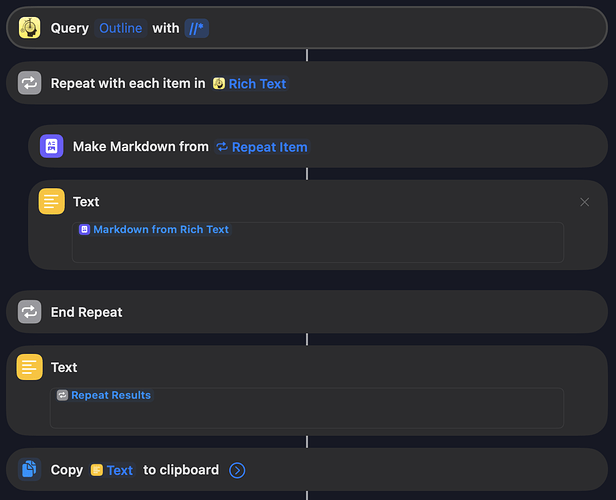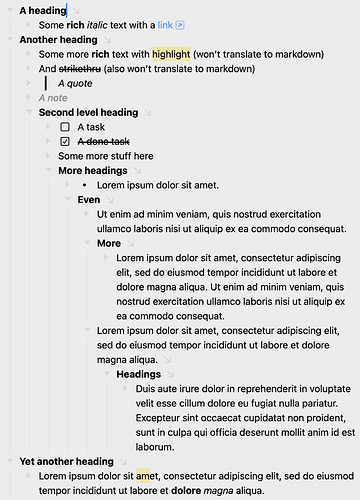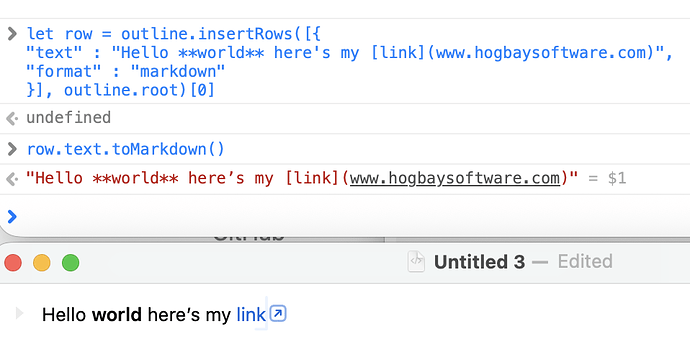It’s been about a year since I tried to integrate this application into my workflow, but without much success. Before writing my account, I would like to emphasize that I am a fervent believer that productivity is maximized with software that operates with and on plain text. Applications like iA Writer, Ulysses, TaskPaper, and similar ones are appreciated for their simplicity and also for the unequivocal way they operate on simple text files. These are files that can be easily exported and manipulated for any other purpose.
Most Outliners are extremely focused on structured to-do lists and project management, an extremely limited view of the possibilities of an Outliner. In my use, I understand an Outliner as a space where I will grow and develop manuscripts. From initial ideas to a final version (I already write more about the final version).
I was happy to discover Bike Outliner because, a priori, it didn’t have a strict emphasis on project and task management. It seemed like an ideal place to develop a written text. However, as I used the application, its enormous limitations made its use pointless for this task.
Review of the current state of Bike Outliner
To make it easier, I will break it down into topics reviewing my view of the application’s functions.
Outline manipulation environment
This is the application’s highlight, as manipulating rows and columns is extremely easy. This helps with rearranging and composing texts. In my view, the possibilities offered by Bike 1 meet all the requirements. Perhaps the only thing missing is, in fact, column filtering when searching, something already implemented in Bike 2. On this point, therefore, Bike Outliner is impeccable. Furthermore, the option for internal links is of enormous help.
Writing environment.
If the Outliner manipulation is impeccable, the writing environment is paltry. The application offers the most rudimentary text editing: italics, bold, and highlights. Any type of minimally more demanding writing cannot be developed within the application.
This fact surprises me because Bike Outline operates on an .html file and there are extensive .html libraries to render, for example: mathematics, footnotes, citations. In fact, markdown itself is just a simplified markup for .html, which is why I don’t effectively understand the reason why Bike Outliner does not natively operate with markdown blocks.
On this point, it is worth noting that the features I highlight (citation, footnotes, mathematics) are useful for various writing professionals (journalists, academics, writers). People who are really very interested in this type of product (like me). The absence of these resources makes any use of Bike Outliner in these workflows unviable. It hinders more than it helps.
Formats and export
This is another bottleneck of Bike Outliner. The .opml format is extremely limited because, in fact, the text of a column is stored as an attribute of a tag in an .xml, something like <row text="row text"/>. In this aspect, all formatting in the text is lost. Obviously, to circumvent these problems, Bike Outliner developed its own .bike format, which is nothing more than an html file, where the text is properly encoded within a tag, not as an attribute.
Exporting to plain text is useless for future applications and the bike format also doesn’t help with integrations. Thus, I consider this aspect extremely limiting, which makes any workflow that aims to integrate Bike Outliner with other applications unviable.
Suggestions for future development
I would like to address future suggestions for the application. In the Outliner manipulation part, as I said, the work is impeccable and I have no recommendations. Therefore, I will focus on the other points.
I believe that the Writing Environment and Formats and Export parts, discussed in the previous item, should be thought of as a whole. At this point, I ask: what is the goal of Bike Outliner? To be an application in itself or to provide future integration?
Defending the viewpoint that Bike Outliner should be part of a larger workflow, I would like to recommend, as soon as possible, that means be developed for the writing environment to integrate more advanced resources, for example: mathematical equations via MathJax; footnotes; subscript and superscript; citations in the pandoc style (i.e., it could just be a highlight in the text, like a different color for the form [@citekey] or even a “box” around the text citekey.) All these topics are not difficult to integrate into an html file, natively used by Bike Outliner.
Assuming that Bike Outliner has this capability, it is natural to export the file to a plain text format .md or .txt with markdown markup. For example, in the case of markdown, export the first six levels of the outline as (h1 ~ h6) and the subsequent rest as simple paragraphs, with the possibility of implementing a marker so that a line is exported as a paragraph, for example:
- H1
- - H2
- - - [x] Paragraph
- - - H3
- - - - [x] Paragraph
- - - - H4
- H1
- - [x] Paragraph
- - H2
...
In this case, the lines marked with [x] would be exported as paragraphs.
The goal would be for Bike Outliner to be the ideal place for texts and manuscripts to be initially developed and grown, to the point that when exported, they could be later manipulated for any purpose via pandoc.
Obviously, I do not expect, nor do I believe it is important, for Bike Outliner to be a complete application, from the starting point to publication, far from it. Therefore, I do not expect Bike Outliner to prepare an entire manuscript, up to the final version for publication. I only suggest that, if the plain text principle is used, the possibilities of Bike Outliner’s applications in the most diverse workflows will be dramatically expanded for many, many writing professionals (and other related ones), while still preserving the simplicity and focus of the application on the conception of written text in a structured way.
Final Considerations
Seeing the current developments of the application, as I said at the beginning, it raised some concern in me, mainly due to a lack of focus or a more opinionated form in the software’s development. I’ll give an example: I constantly have to prepare slides for presentations, whether in seminars, lectures, and the like. I tried various ways, from the native Mac application (slow, annoying); workflows with reveal.js (unnecessarily complicated and with more focus on ornaments than text); even with the breamer class of LaTeX (more focused than the other two, but the portability of the text (markup in TeX) weighs a bit against its use).
In the meantime, the iA Writer team launched iA Presenter and I confess that I tested the application for two days and already bought it. The workflow is opinionated, the themes are limited, but none of this matters, since it has the basic functions provided by Markdown and the export formats are excellent. In short, it’s an application that I open and start working on, without any distraction or headache. They deliver a ready-made workflow to me, extremely well-organized and well-done. I can develop my work and make other integrations without many problems. The virtual limitations of customization (image placement, text size, etc.) have no impact on the final work.
Basically, this is what I miss in Bike Outliner; it’s not clear what the application’s objective is, what problem it tackles. Would it be a new project manager? A place for structured writing? Structured writing, but of what type? Is there any direction that the implemented resources point to?
Another point that brings me some concern is the API system.
Although it is interesting to develop an API for plugins and other customizations, the vast majority (of users) are not interested in this type of thing. The fact that I pay for software is so that it facilitates my work and doesn’t give me more headaches. Obviously, I have no (and many others don’t) desire to write a plugin in .js, much less “waste time” reading yet another software documentation. My goal is simple: open Bike Outliner and write, nothing more than that. After that, export my result and handle the final part of the work appropriately. This API part can even be a shot in the foot for niche applications like Bike Outliner, as it allocates a lot of effort to sustain an architecture that will be used by a small part of the users. Time that could be allocated to the development of features in a more opinionated way.
To conclude, unfortunately, despite trying in various ways, I couldn’t fit Bike Outliner into my workflow and, seeing the recent developments, in the near future I can’t see how Bike Outliner could be used as a text development resource through structured writing.
Finally, I don’t want this text to be read as an attack, but just a reflection. Obviously, the developer’s opinionated is different from the user’s opinionated. However, the true strength of opinionated resources lies in the cohesive and solid way they integrate features, without depending on external items, and also in the clear direction with which they develop the features, delivering a work environment conducive to the user.


